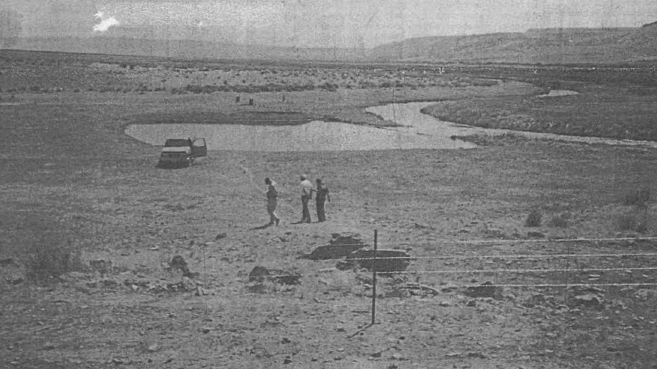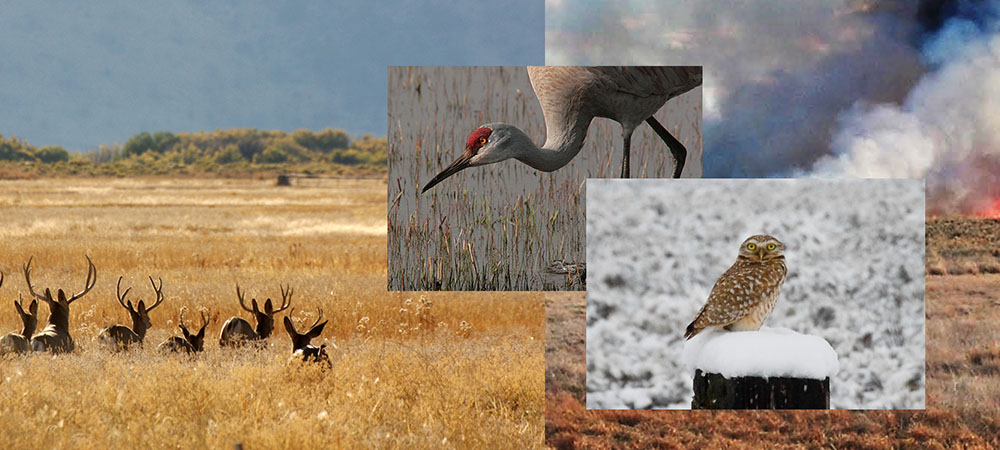During a Twitter exchange with Jonathan Wood, from the Pacific Legal Foundation, Jonathan sent me a link to a Cato Institute article on the armed takeover of the Malheur National Wildlife Refuge. The Cato article condemns the Bundy actions, even as it deplores what it views as an overly harsh penalty for the ranchers (Dwight and Steven Hammond) at the center of the dispute.
The article notes that neither the Bundys nor the Hammonds are exactly poster children for the land use movement:
Property rights advocates who want to change public views need to find ranchers more appealing than the Bundys, who want to overgraze other people’s land without paying for the right to do so, or the Hammonds, whose unauthorized fire on federal lands threatened firefighters’ lives. Without better representatives–preferably ones willing to pay their own way and not rely on taxpayer subsidies–they won’t be able to capture the hearts and minds of the American people, which means the future of ranchers who depend on federal lands is dim.
The article also mentions Section 8 of the Constitution, which property and states rights people continually use to demand that the federal government turn over land to state control.
I can agree with the author, Randal O’Toole in his assessment of the Bundys and Hammonds, but disagree with him about the severity of the punishment the Hammonds received. And I disagree with his reference to Section 8, without mentioning the Property Clause, which does give the government right to own land:
The Congress shall have Power to dispose of and make all needful Rules and Regulations respecting the Territory or other Property belonging to the United States.
However, even without mentioning the Property Clause, O’Toole does note that the only way to battle federal land ownership is via Congressional action:
The Supreme Court has heard hundreds of cases involving federal land and has never ruled that the Constitution does not allow the federal government to own land in the West. So any battle against federal ownership would have to be fought politically, not in the courts.
Supreme Court decisions have upheld the federal government’s right to own and maintain land, until and unless, Congress revokes this right. And even attempts by President Reagan to sell off all federal land failed. Why? As a Washington Post article notes, private ownership of the land didn’t suit ranchers because they would lose the free ride they’ve had from the government. In addition, environmentalists rose in one body to demand the government stop its actions. And it wasn’t just environmentalists who were alarmed: something about paving over Yellowstone, and putting McDs in the Grand Canyon just doesn’t quite suit the majority of people in this country.
Returning to O’Toole’s criticism of the sentence the Hammonds received, was the punishment unjust?
It’s unfortunate that the law the Hammonds were charged under is named The Antiterrorism and Effective Death Penalty Act, because everyone focused on “terrorism” in defense of the Hammonds. The Hammonds aren’t terrorists, the critics scoffed.
Of course they aren’t terrorists. To call them terrorists is to lessen acts such as the recent shootings in California and Paris. But the Hammonds were tried and convicted, by a jury of their peers, for the following:
Whoever maliciously damages or destroys, or attempts to damage or destroy, by means of fire or an explosive, any building, vehicle, or other personal or real property in whole or in part owned or possessed by, or leased to, the United States, or any department or agency thereof, or any institution or organization receiving Federal financial assistance, shall be imprisoned for not less than 5 years and not more than 20 years, fined under this title, or both.
Dwight and Steven Hammond were convicted of deliberately setting a fire on federal land in 2001 that burned 139 acres. In addition, Steven Hammond was convicted of setting fire to federal land in 2006. They both claimed to be burning invasive species, or in the latter fire, protecting a crop of winter wheat. However, it was not their call to make—not only to set fire to federal land, but to their neighbor’s land, when the fire spread; particularly when it comes to a wildlife refuge, where incorrectly set fires could prove detrimental to not individual birds, but an entire species if endangered birds are threatened.
In addition, the 2001 fire was created not to burn invasive species, as the Hammonds imply, but to cover up an illegal deer hunt, according to a relative of the Hammonds who testified against them. They also endangered a three-person fire crew during the 2006 fire, almost trapping them behind a fire line. All of the Hammond fires, not just the two related to the criminal case, ended up costing the government over $600,000. The government sued the pair after the fires, and was able to recover $200,000, but we tax payers ended up footing the bill for the rest. The Oregonian noted the Hammonds paid $200,000 in 2014, and the rest, recently. That still leaves at least $200,000, or more, firefighting costs and damages to the tax payers.
The judge who originally sentenced them claimed that the mandatory five year sentence shouldn’t apply, because the fire was a “wilderness” fire, and in his opinion, that wasn’t what Congress intended for this law. However, I think we’ve all seen enough of “wilderness” fires this last year to know they are deadly, they are dangerous, they destroy homes, pets, people…they can even destroy entire towns. The appeals courts, rightfully, dismissed the unlawful sentencing and imposed the five year minimum.
Here, we need not progress beyond the first step.
Congress has “broad authority” to determine the appropriate
sentence for a crime and may justifiably consider arson,
regardless of where it occurs, to be a serious crime. Solem v.
Helm, 463 U.S. 277, 290 (1983). Even a fire in a remote area
has the potential to spread to more populated areas, threaten
local property and residents, or endanger the firefighters
called to battle the blaze. The September 2001 fire here,
which nearly burned a teenager and damaged grazing land,
illustrates this very point.
Given the seriousness of arson, a five-year sentence is not
grossly disproportionate to the offense.
This wasn’t the Hammonds’ first act of arrogant disregard for the welfare or concerns of others, either. When FWS attempted to build a fence to keep the Hammonds’ cattle out of the Refuge land around a watering spot, Steven Hammond parked a 25-ton Caterpillar earth mover on the fence line and refused to move it. Not only refused to move it, forcibly dropped the earth mover’s shovel near one of the federal employees in an act of intimidation.
The Hammonds were arrested for their actions, but pressure from land-use groups, and Representative Wes Cooley, most likely kept them from being prosecuted.

Cooley would later testify in a budget hearing for the Fish & Wildlife Service that the Hammonds had a successful injunction against the FWS, which would then allow them access to the land, but I can find no record in PACER to corroborate this statement. However, I did find an agreement between the Hammonds and various other organizations, including FWS, related to water rights in the region. This agreement did not specify that the Hammonds had the right to drive their cattle into the FWS land, only that they may divert water during the spring to another reservoir.
The Hammonds also refused to allow federal firefighting crews access to their land so they could fight fires, and tried to get the local Sheriff to arrest the crew for doing so.
As part of the sentencing deal the Hammonds made with the government, they agreed to give FWS first rights to purchase a parcel of Hammond property, but only if the Hammonds had to sell it in order to pay their fines. The Hammonds were able to pay their fines without selling the land, so the new adherence to the minimum sentence had nothing to do with a government attempt to get the Hammond land, contrary to what the land-use fanatics are proclaiming.
Misdirection and misinformation is a hallmark of any of the activities associated with the Hammonds. It is difficult to find the truth, among all the misrepresentations. Enforcing laws against people like the Hammonds isn’t all peaches and cream, either. In the article, Peril in the West: Enforcing Environment Laws Gets Scary, the author begins with:
Someone has threatened to kill Forrest Cameron, and to harm his wife and children.
Cameron, the manager of the Malheur National Wildlife Refuge, knows who threatened to kill him, and why. He doesn’t know who called his home in Princeton, Ore., to harass his wife and daughters. But he assumes it’s for the same reason he says Dwight Hammond threatened to shoot him: because Cameron was enforcing the law.
At least Hammond is consistent, he also threatened refuge managers in 1986 and 1988. No, I don’t find a sentence of five years to be disproportionate, at all.
As for Bundy boys, rather than piss in their own pond, they went to Oregon to piss in someone else’s. And that’s the least negative thing I can say about them.
Photo compilation:
Photos of Malheur National Wildlife Refuge
Sandhill Crane: Roger Baker, USFWS
Mule Deer: Barbara Wheeler, USFWS
Prescribed Burn: Carla Burnside, USFWS
Owl: Jim Maloney, USFWS
Arrest photo of Dwight Hammond from article about the arrest in the Burns Times-Herald, August 10, 1994.

